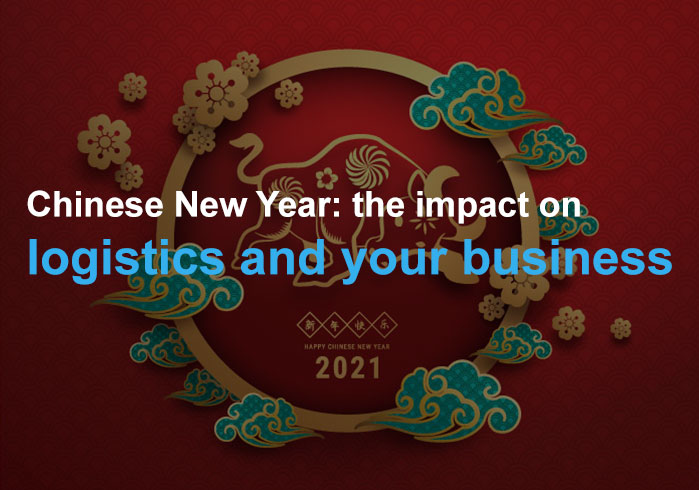
When it comes to international production and shipping volumes, specific events tend to trigger an upsurge in demand including Black Friday, Cyber Monday, Hanukkah, and Christmas, which all occur in a small time frame and create a peak season for shipping and operations. During this peak season, managers need to think ahead and prepare their business for changes in demand.
However, there is another massive wave of increased spending surrounding the Lunar New Year, a holiday celebrated by millions of people worldwide, particularly throughout China and Southeast Asia. During Lunar New Year, many businesses in the region close for public holidays. For logistics companies and those that rely on them, the Lunar New Year can mean significant delays to shipments which can negatively impact the supply chain, Yet with strategic preparation, businesses can prepare for holiday delays and continue operations without disruption during the Chinese New Year.
Of course, 2020 has also brought a global pandemic and a new set of unpredictable fluctuations, making it even more imperative that logistics leaders have contingency plans to ensure their operations continue.
What is Lunar New Year 2021?
The Lunar New Year is a Spring Festival celebrated throughout China and Southeast Asia which marks the end of the winter. It’s also widely known as the Chinese New Year, as it marks the beginning of the traditional Chinese calendar. It is considered one of the most important events in China, and is widely celebrated throughout the country with business closures and increased travel as families and friends gather to celebrate.
When is the Lunar New Year 2021?
According to the traditional Chinese calendar, which follows a lunar pattern, the exact date of the Lunar New Year can vary slightly. This year, the Lunar New Year falls on Friday, February 12, 2021. Officially, Lunar New Year celebrations last up to seven days, beginning on Lunar New Year’s Eve and continuing through the sixth day of the first lunar month. Thus, Lunar New year 2021 is expected to occur between February 11 and February 17, with many businesses and schools closed. However, celebrations can often run until the Lantern Festival, which is February 26.
How does Lunar New Year Impact Businesses?
With extended public holidays, many workers receive extra time off work to celebrate and travel with family. The absence of workers from their stations affects the logistics of shipping companies and other transporters. Combined with the high demand for specific goods that are related to the festivities, there is likely to be a significant delay in shipping operations. Factories are likely to shut down for the duration of the festivities and the same pattern will be seen in other countries that celebrate the Lunar New Year. Businesses must be prepared for the impact of extended week-long festivities.
The Impact on Your Supply Chain
Closed factories and the unavailability of staff to work on orders can have a huge impact on production, and these delays tend to go on for some time after the festivities because the re-opening of factories is a gradual process: some operations take a full month to get back to capacity. Not only China, but many surrounding Southeast Asian countries are affected. In addition to production disruption, international freight and shipping for the entire southeast Asia region may be negatively impacted during Lunar New Year festivities.
It is important to plan workarounds for the Lunar New Year, in part because many other shippers will also be booking inventory buffers. If you deal with high volumes of production, it is imperative to communicate with your logistics partners as well as other cargo participants to ensure you are making plausible forecasts and preparing fully.
How to Prepare for Lunar New Year 2021
If you have any business links to Southeast Asia and China, you need to plan for the Lunar New Year. That means understanding the orders that you need and the timescales that you have to hit. Think about how you can better coordinate with your supply chain partners to address any blockages in the chain. Use a holistic approach that does not just focus on shipping, but also loading and storage.
Think about the entire transportation framework including shipping, trucking, and warehousing so a break in any section of the supply chain does not impact your output. One recommendation is to build strong relationships with air freight companies year-round so that you receive priority treatment when there is a huge backlog. The relationships that you have built with suppliers will be instrumental in giving you that extra leverage when the transportation networks are clogged by additional demand. You will also be able to better meet the needs of your customers because you will already have built up contingency capacity.
Now that orders are picking back up in the wake of the COVID-19 pandemic, it is necessary to make adjustments to your schedules and bookings. The vaccines that are on the market at the moment promise relief, but there is also uncertainty about new strains of the virus that may be coming out. Be aware of the market’s fluidity and try to have contingency plans for every element of your operations.
Wrapping Up
The Chinese New Year is February 12, 2021, but businesses, factories, and companies – particularly throughout China and Southeast Asia – may close as early as February 11 and stay closed for a week or more. Businesses that rely on this part of the world for their supply chain should prepare by booking routes and carriers. Businesses and shippers should also coordinate with partners and customers to prepare foolproof contingency plans so that business can carry on as usual during the widespread festivities.


